Effect of Wind Speed on Moderate Resolution Imaging Spectroradiometer (MODIS) Aerosol Optical Depth over the North Pacific
Abstract
:1. Introduction
2. Data, Methodology and Investigation Area
2.1. Moderate Resolution Imaging Spectroradiometer (MODIS) Aerosol Retrievals
2.2. Aerosol Optical Depth (AOD) from Sun Photometer Measurements
2.3. Investigation Area: Central North Pacific
2.4. FLEXible TRAjectories (FLEXTRA) Trajectory Model
3. Results
3.1. Validation of MODIS AOD against Ground-Based Measurements
3.2. Evaluation of MODIS-Derived AOD versus Surface Wind Speed
3.3. Aerosol Robotic Network (AERONET) Free Tropospheric AOD
3.4. Air Mass Transport
3.5. Power-Law Relationship between MODIS AOD and Surface-Wind Speed
3.6. Comparison with Previous Studies
3.7. Comparison between MODIS Collections 5 and 6
4. Discussion
5. Conclusions
Acknowledgments
Author Contributions
Conflicts of Interest
References
- Lewis, E.R.; Schwartz, S.E. Sea Salt Aerosol Production: Mechanisms, Methods, Measurements and Models—A Critical Review; American Geophysical Union: Washington, DC, USA, 2004. [Google Scholar]
- Kieber, D.J.; Keene, W.C.; Frossard, A.A.; Long, M.S.; Maben, J.R.; Russell, L.M.; Kinsey, J.D.; Tyssebotn, I.M.B.; Quinn, P.K.; Bates, T.S. Coupled ocean atmosphere loss of marine refractory dissolved organic carbon. Geophys. Res. Lett. 2016, 43, 2765–2772. [Google Scholar] [CrossRef]
- Haywood, J.; Ramaswamy, V.; Soden, B. Tropospheric aerosol climate forcing in clear sky satellite observation over the oceans. Science 1999, 283, 1299–1303. [Google Scholar] [CrossRef] [PubMed]
- Grini, A.; Myhre, G.; Sundet, J.K.; Isaksen, I.S.A. Modeling the annual cycle of sea salt in the Global 3D Model Oslo CTM2, concentrations, fluxes and radiative impact. J. Clim. 2002, 15, 1717–1730. [Google Scholar] [CrossRef]
- Dobbie, S.; Li, J.; Harvey, R.; Chylek, P. Sea-salt optical properties and GCM forcing at solar wavelengths. Atmos. Res. 2003, 65, 211–233. [Google Scholar] [CrossRef]
- Ayash, T.; Gong, S.; Jia, C.Q. Direct and indirect shortwave radiative effects of sea salt aerosols. J. Clim. 2008, 21, 3207–3220. [Google Scholar] [CrossRef]
- Struthers, H.; Ekman, A.M.L.; Glantz, P.; Iversen, T.; Kirkevåg, A.; Mårtensson, E.M.; Seland, Ø.; Nilsson, E.D. The effect of sea ice loss on sea salt aerosol concentrations and the radiative balance in the Arctic. Atmos. Chem. Phys. 2011, 11, 3459–3477. [Google Scholar] [CrossRef]
- Pierce, J.R.; Adams, P.J. Global evaluation of CCN formation by direct emission of sea salt and growth of ultrafine sea salt. J. Geophys. Res. 2006, 111, D06203. [Google Scholar] [CrossRef]
- Fan, T.; Toon, O.B. Modeling sea-salt aerosol in a coupled climate and sectional microphysical model: Mass, optical depth and number concentration. Atmos. Chem. Phys. 2011, 11, 4587–4610. [Google Scholar] [CrossRef] [Green Version]
- Nilsson, E.D.; Rannik, Ü.; Swietlicki, E.; Leck, C.; Aalto, P.P.; Zhou, J.; Norman, M. Turbulent aerosol fluxes over the Arctic Ocean 2. Wind driven sources from the sea. J. Geophys. Res. 2001, 106, 32139–32154. [Google Scholar] [CrossRef]
- Mårtensson, E.M.; Nilsson, E.D.; de Leeuw, G.; Cohen, L.H.; Hansson, H.C. Laboratory simulations and parameterization of the primary marine aerosol production. J. Geophys. Res. 2003, 108, 4297. [Google Scholar] [CrossRef]
- Glantz, P.; Svensson, G.; Noone, K.J.; Osborne, S.R. Sea-salt aerosols over the Northeast Atlantic: Model simulations of ACE-2 2nd Lagrangian experiment. Q. J. R. Meteorol. Soc. 2004, 130, 2191–2215. [Google Scholar] [CrossRef]
- De Leeuw, G.; Andreas, E.L.; Anguelova, M.D.; Fairall, C.W.; Lewis, E.R.; O’Dowd, C.; Schulz, M.; Schwartz, S.E. Production flux of sea spray aerosol. Rev. Geophys. 2011, 49, RG2001. [Google Scholar] [CrossRef]
- Lundgren, K.B.; Vogel, H.; Kottmeier, C. Direct radiative effects of sea salt for the Mediterranean region under conditions of low to moderate wind speeds. J. Geophys. Res. Atmos. 2013, 118, 1906–1923. [Google Scholar] [CrossRef]
- Geever, M.; O’Dowd, C.; van Ekeren, S.; Flanagan, R.; Nilsson, D.; de Leeuw, G.; Rannik, U. Sub-micron sea-spray fluxes. Geophys. Res. Lett. 2005, 32, L15810. [Google Scholar] [CrossRef]
- Salter, M.E.; Nilsson, E.D.; Butcher, A.; Merete, B. On the seawater temperature dependence of continuous plunging jet derived sea spray aerosol. J. Geophys. Res. Atmos. 2014, 119, 9052–9072. [Google Scholar] [CrossRef]
- Salter, M.E.; Zieger, P.; Acosta Navarro, J.C.; Grythe, H.; Kirkevag, A.; Rosati, B.; Riipinen, I.; Nilsson, E.D. An empirically derived inorganic sea spray source function incorporating sea surface temperature. Atmos. Chem. Phys. 2015, 15, 11047–11066. [Google Scholar] [CrossRef] [Green Version]
- Woodcock, A.H.; Gilford, M.M. Sampling atmospheric sea salt. Marine Res. 1948, 8, 177–197. [Google Scholar]
- Blanchard, D.C. The production, distribution and bacterial enrichment of the sea-salt aerosol. In The Air-Sea Exchanges of Gases and Particles; Liss, P.S., Slinn, W.G.N., Eds.; D. Reidel: Norwell, MA, USA, 1983; pp. 407–454. [Google Scholar]
- Monahan, E.C.; Spiel, D.E.; Davidson, K.L. A model of marine aerosol generation via whitecaps and wave disruption. In Oceanic Whitecaps; Monahan, E.C., MacNiochaill, G., Eds.; D. Reidel: Norwell, MA, USA, 1986; pp. 167–193. [Google Scholar]
- Nicholls, S. The dynamics of stratocumulus–aircraft observations and comparisons with a mixed layer model. Q. J. R. Meteorol. Soc. 1984, 110, 783–820. [Google Scholar] [CrossRef]
- Bretherton, C.S.; Austin, P.; Siems, S.T. Cloudiness and marine boundary layer dynamics in the ASTEX Lagrangian experiments. Part II: Cloudiness, drizzle, surface fluxes and entrainment. J. Atmos. Sci. 1995, 52, 2724–2735. [Google Scholar] [CrossRef]
- Johnson, D.W.; Osborne, S.; Wood, R.; Suhre, K.; Quinn, P.K.; Bates, T.S.; Andreae, M.O.; Noone, K.; Glantz, P.; Bandy, B.; et al. Observations of the evolution of the aerosol, cloud and boundary layer characteristics during the 1st ACE-2 Lagrangian experiment. Tellus 2000, 52B, 348–376. [Google Scholar] [CrossRef]
- Osborne, S.R.; Johnson, D.W.; Wood, R.; Bandy, B.J.; Andreae, M.O.; O’Dowd, C.D.; Glantz, P.; Noone, K.; Gerbig, C.; Rudolph, J.; et al. Evolution of the aerosol, cloud and boundary layer dynamic and thermodynamic characteristics during the second Lagrangian experiment of ACE-2. Tellus 2000, 52B, 375–400. [Google Scholar] [CrossRef]
- Wood, R.; Johnson, D.; Osborne, S.; Andreae, M.O.; Bandy, B.; Bates, T.; O’Dowd, C.; Glantz, P.; Noone, K.; Quinn, P.; et al. Boundary layer and aerosol evolution during the 3rd Lagrangian experiment of ACE-2. Tellus 2000, 52B, 239–257. [Google Scholar]
- Clarke, A.D.; Uehara, T.; Porter, J.N. Lagrangian evolution of an aerosol column during the Atlantic Stratocumulus Transition Experiment. J. Geophys. Res. 1996, 101, 4351–4362. [Google Scholar] [CrossRef]
- Gong, S.L.; Bartie, L.A.; Blanchet, J.P. Modeling sea-salt aerosols in the atmosphere. Model development. J. Geophys. Res. 1997, 102, 3805–3818. [Google Scholar] [CrossRef]
- Reid, J.S.; Brooks, B.; Crahan, K.K.; Hegg, D.A.; Eck, T.F.; O’Neill, N.; de Leeuw, G.; Reid, E.A.; Anderson, K.D. Reconciliation of coarse mode sea-salt aerosol particle size measurements and parameterizations at a subtropical ocean receptor site. J. Geophys. Res. 2006, 111, D02202. [Google Scholar] [CrossRef]
- Textor, C.; Schulz, M.; Guibert, S.; Kinne, S.; Balkanski, Y.; Bauer, S.; Berntsen, T.; Berglen, T.; Boucher, O.; Chin, M.; et al. Analysis and quantification of the diversities of aerosol life cycles within AeroCom. Atmos. Chem. Phys. 2006, 6, 1777–1813. [Google Scholar] [CrossRef]
- Glantz, P.; Bourassa, A.; Herber, A.; Iversen, T.; Karlsson, J.; Kirkevåg, A.; Maturilli, M.; Seland, Ø.; Stebel, K.; Struthers, H.; et al. Remote sensing of aerosols in the Arctic for an evaluation of global climate model simulations. J. Geophys. Res. 2014, 119, 8169–8188. [Google Scholar] [CrossRef] [Green Version]
- Grythe, H.; Ström, J.; Krejci, R.; Quinn, P.; Stohl, A. A review of sea-spray aerosol source functions using a large global set of sea salt aerosol concentration measurements. Atmos. Chem. Phys. 2014, 14, 1277–1297. [Google Scholar] [CrossRef] [Green Version]
- Smirnov, A.; Holben, B.N.; Eck, T.F.; Dubovik, O.; Slutsker, I. Effect of wind speed on columnar aerosol optical properties at Midway Island. J. Geophys. Res. 2003, 108, 4802. [Google Scholar] [CrossRef]
- Lehahn, Y.; Koren, I.; Boss, E.; Ben-Ami, Y.; Altaratz, O. Estimating the maritime component of aerosol optical depth and its dependency on surface wind speed using satellite data. Atmos. Chem. Phys. 2010, 10, 6711–6720. [Google Scholar] [CrossRef]
- Huang, H.; Thomas, G.E.; Grainger, R.G. Relationship between wind speed and aerosol optical depth over remote ocean. Atmos.Chem. Phys. 2010, 10, 5943–5950. [Google Scholar] [CrossRef]
- Kiliyanpilakkil, V.P.; Meskhidze, N. Deriving the effect of wind speed on clean maritime aerosol optical properties using the A-Train satellites, Atmos. Chem. Phys. Discuss. 2011, 11, 4599–4630. [Google Scholar] [CrossRef]
- Mulcahy, J.P.; O’Dowd, C.D.; Jennings, S.D.; Ceburnus, D. Significant enhancement of aerosol optical depth in marine air under high wind conditions. Geophys. Res. Lett. 2008, 35, L16810. [Google Scholar] [CrossRef]
- Glantz, P.; Nilsson, E.D.; von Hoyningen-Huene, W. Estimating a relationship between aerosol optical thickness and surface wind speed over the ocean. Atmos. Res. 2009, 92, 58–68. [Google Scholar] [CrossRef]
- Satheesh, S.; Moorthy, K. Contribution of sea-salt to aerosol optical depth over the Arabian Sea derived from MODIS observations. Geophys. Res. Lett. 2006, 33. [Google Scholar] [CrossRef]
- Tanré, D.; Kaufman, Y.J.; Herman, M.; Mattoo, S. Remote sensing of aerosol properties over oceans using the MODIS/EOS spectral radiances. J. Geophys. Res.-Atmos. 1997, 102, 16971–16988. [Google Scholar]
- Levy, R.C.; Remer, L.A.; Tanré, D.; Kaufman, Y.J.; Ichoku, C.; Holben, B.N.; Livingston, J.M.; Russel, P.B.; Maring, M. Evaluation of the MODIS retrievals of dust aerosol over the ocean during PRIDE. J. Geophys. Res. 2003, 108, 8594. [Google Scholar] [CrossRef]
- Levy, R.; Remer, L.A.; Dubovik, O. Global aerosol optical properties and application to MODIS aerosol retrieval over land. J. Geophys. Res. 2007, 112, D13210. [Google Scholar] [CrossRef]
- Levy, R.C.; Remer, L.A.; Kleidman, R.G.; Mattoo, S.; Ichoku, C.; Kahn, R.; Eck, T.F. Global evaluation of the Collection 5 MODIS dark-target aerosol products over land. Atmos. Chem. Phys. 2010, 10, 10399–10420. [Google Scholar] [CrossRef] [Green Version]
- Levy, R.C.; Mattoo, S.; Munchak, L.A.; Remer, L.A.; Sayer, A.M.; Patadia, F.; Hsu, N.C. The Collection 6 MODIS aerosol products over land and ocean. Atmos. Meas. Tech. 2013, 6, 2989–3034. [Google Scholar] [CrossRef]
- Remer, L.A.; Kaufman, Y.J.; Tanre, D.; Mattoo, S.; Chu, D.A.; Martins, J.V.; Li, R.R.; Ichoko, C.; Levy, R.C.; Kleidman, R.G.; et al. The MODIS aerosol algorithm, products, and validation. J. Atmos. Sci. 2005, 62, 947–973. [Google Scholar] [CrossRef]
- Holben, B.N.; Eck, T.F.; Slutsker, I.; Tanre, D.; Buis, J.P.; Setzer, A.; Vermote, E.F.; Reagan, J.A.; Kaufman, Y.J.; Nakajima, T.; et al. AERONET—A federated instrument network and data archive for aerosol characterization. Remote Sens. Environ 1998, 66, 1–16. [Google Scholar] [CrossRef]
- Smirnov, A.; Holben, B.N.; Slutsker, I.; Giles, D.M.; McClain, C.R.; Eck, T.F.; Sakerin, S.M.; Macke, A.; Croot, P.; Zibordi, G.; et al. Maritime Aerosol Network as a component of Aerosol Robotic Network. J. Geophys. Res. 2009, 114, D06204. [Google Scholar] [CrossRef]
- Garza, J.A.; Chu, P.; Norton, C.W.; Schroeder, T.A. Changes of the prevailing trade winds over the islands of Hawaii and the North Pacific. J. Geophys. Res. 2012, 117, D11109. [Google Scholar] [CrossRef]
- Stohl, A.; Wotawa, G.; Seibert, P.; Kromp-Kolb, H. Interpolation errors in wind fields as a function of spatial and temporal resolution and their impact on different types of kinematic trajectories. J. Appl. Metereol. 1995, 34, 2149–2165. [Google Scholar] [CrossRef]
- Stohl, A.; Seibert, P. Accuracy of trajectories as determined from the conservation of meteorological tracers. Q. J. R. Meteorol. Soc. 1998, 125, 1465–1484. [Google Scholar] [CrossRef]
- Mishchenko, M.I.; Liu, L.; Geogdzhayev, I.V.; Travis, L.D.; Cairns, B.; Lacis, A.A. Toward unified satellite climatology of aerosol properties. 3. MODIS versus MISR versus AERONET. J. Quant. Spectrosc. Radiat. Transf. 2010, 111, 540–552. [Google Scholar] [CrossRef]
- Monahan, E.C.; O’Muircheartaigh, I. Optimal power-law description of oceanic whitecap coverage dependence on wind speed. J. Phys. Oceanogr. 1980, 10, 2094–2099. [Google Scholar] [CrossRef]
- Callaghan, A.; de Leeuw, G.; Cohen, L.; O’Dowd, C.D. Relationship of oceanic whitecap coverage to wind speed and wind history. Geophys. Res. Lett. 2008, 35, L23609. [Google Scholar] [CrossRef]
- Norris, S.J.; Brooks, I.M.; Moat, B.I.; Yelland, M.J.; de Leeuw, G.; Pascal, R.W.; Brooks, B. Near-surface measurements of sea spray aerosol production over whitecaps in the open oceam. Ocean. Sci. 2013, 9, 133–145. [Google Scholar] [CrossRef]
- Albert, M.F.M.A.; Anguelova, M.D.; Manders, A.M.M.; Schaap, M.; de Leeuw, G. Parameterization of oceanic whitecap fraction based on satellite observations. Atmos. Chem. Phys. 2016, 16, 13725–13751. [Google Scholar] [CrossRef]
- Smirnov, A.; Sayer, A.M.; Holben, B.N.; Hsu, N.C.; Sakerin, S.M.; Macke, A.; Nelson, B.B.; Courcoux, Y.; Smyth, T.J.; Croot, P.; et al. Effect of wind speed on aerosol optical depth over remote oceans, based on data from the Maritime Aerosol, Network. Atmos. Meas. Tech. 2012, 5, 377–388. [Google Scholar] [CrossRef] [Green Version]
- O’Dowd, C.D.; Scannell, C.; Mulcahy, J.; Jennings, S.G. Wind speed influences on marine aerosol optical depth. Adv. Meteorol. 2010. [Google Scholar] [CrossRef]
- Shinozuka, Y.; Clarke, A.D.; Howell, S.G.; Kapustin, V.N.; Huebert, B.J. Sea-salt vertical profiles over the Southern and tropical Pacific oceans: Microphysics, optical properties, spatial variability, and variations with wind speed. J. Geophys. Res. 2004, 109, D24201. [Google Scholar] [CrossRef]
- Wu, J. Oceanic Whitecaps and Sea State. J. Phys. Oceanogr. 1979, 9, 1064–1068. [Google Scholar] [CrossRef]
- Ichoku, C.; Chu, D.A.; Mattoo, S.; Kaufman, Y.J.; Remer, L.A.; Tanré, D.; Slutsker, I.; Holben, B.N. A spatio-temporal approach for global validation and analysis of MODIS aerosol products. Geophys. Res. Lett. 2002, 29, 8006. [Google Scholar] [CrossRef]
- Zhang, J.; Reid, J.S. MODIS aerosol product analysis for data assimilation: Assessment of over-ocean level 2 aerosol optical thickness retrievals. J. Geophys. Res. 2006, 111, D22207. [Google Scholar] [CrossRef]
- Shi, Y.; Zhang, J.; Reid, J.S.; Holben, B.; Hyer, E.J.; Curtis, C. An analysis of the collection 5 MODIS over-ocean aerosol optical depth product for its implication in aerosol assimilation. Atmos. Chem. Phys. 2011, 11, 557–565. [Google Scholar] [CrossRef] [Green Version]
- Zhang, J.; Reid, J.; Holben, B. An analysis of potential cloud artifacts in MODIS over ocean aerosol optical thickness products. Geophys. Res. Lett. 2005, 32, L15803. [Google Scholar] [CrossRef]
- Mélin, F. Comparison of SeWiFS and MODIS time series of inherent properties for the Adriatic Sea. Ocean. Sci. 2011, 7, 351–361. [Google Scholar] [CrossRef]
- Mélin, F.; Zibordi, G.; carlund, T.; Holben, B.N.; Stefan, S. Validation of SeaWiFS and MODIS Aqua/Terra aerosol products in coastal regions of European marginal seas. Oceanologia 2013, 55, 27–51. [Google Scholar] [CrossRef]
- Tesche, M.; Glantz, P.; Johansson, C. Spaceborne observations of low surface aerosol concentrations in the Stockholm region. Tellus B 2016, 68, 28951. [Google Scholar] [CrossRef]
- Glantz, P.; Freud, E.; Johansson, C.; Tesche, M. Trends in MODIS and AERONET derived aerosol optical thickness over Northern Europe. Tellus 2018. under review. [Google Scholar]
- Forster, C.; Cooper, O.; Stohl, A.; Eckhardt, S.; James, P.; Dunlea, E.; Nicks, D.K., Jr.; Holloway, J.S.; Hubler, G.; Parrish, D.D.; et al. Lagrangian transport model forecasts and a transport climatology for the Intercontinental Transport and Chemical Transformation 2002 (ITCT 2K2) measurement campaign. J. Geophys. Res. 2004, 109, D07S92. [Google Scholar] [CrossRef]
- Liang, Q.; Jaegle, L.; Jaffe, D.A.; Weiss-Penzias, P.; Heckman, A.; Snow, J.A. Long range transport of Asian pollution to the northeast Pacific: Seasonal variations and transport pathways of carbon monoxide. J. Geophys. Res. 2004, 109, D23S07. [Google Scholar] [CrossRef]
- Heald, C.L.; Jacob, D.J.; Park, R.J.; Alexander, B.; Fairlie, T.D.; Yantosca, R.M.; Chu, D.A. Transpacific transport of Asian anthropogenic aerosols and its impact on surface air quality in the United States. J. Geophys. Res. 2006, 111, Dl4310. [Google Scholar] [CrossRef]
- Yu, H.; Chin, M.; Remer, L.; Kleidman, R.G.; Bellouin, N.; Bian, H.; Diehl, T. Variability of marine aerosol fine-mode fraction and estimates of anthropogenic aerosol component over cloud-free oceans from the Moderate Resolution Imaging Spectroradiometer (MODIS). J. Geophys. Res. 2009, 114, D10206. [Google Scholar] [CrossRef]
- Darzi, M.; Winchester, J.W. Resolution of basaltic and continental aerosol components during spring and summer within the boundary layer of Hawaii. J. Geophys. Res. 1982, 87, 7262–7272. [Google Scholar] [CrossRef]
- Uematsu, D.R.A.; Prospero, J.M.; Chen, L.; Merrill, J.T.; McDonald, R.L. Transport of mineral aerosol from Asia over the North Pacific Ocean. J. Geophys. Res. 1983, 88, 5343–5352. [Google Scholar] [CrossRef]
- Takemura, T.; Nakajima, T.; Dubovik, O.; Holben, B.N.; Kinne, S. Single-scattering albedo and radiative forcing of various aerosol species with a global three-dimensional model. J. Clim. 2002, 15, 333–352. [Google Scholar] [CrossRef]
- Chin, M.; Diehl, T.; Ginoux, P.; Malm, W. Intercontinental transport of pollution and dust aerosols: Implications for regional air quality. Atmos. Chem. Phys. Disccuss. 2007, 7, 9013–9051. [Google Scholar] [CrossRef]
- Huang, J.; Minnis, P.; Chen, B.; Huang, Z.; Liu, Z.; Zhao, Q.; Yi, Y.; Ayers, K.J. Long-range transport and vertical structure of Asian dust from CALIPSO and surface measurements during PACDEX. J. Geophys. Res. 2008, 113, D23212. [Google Scholar] [CrossRef]
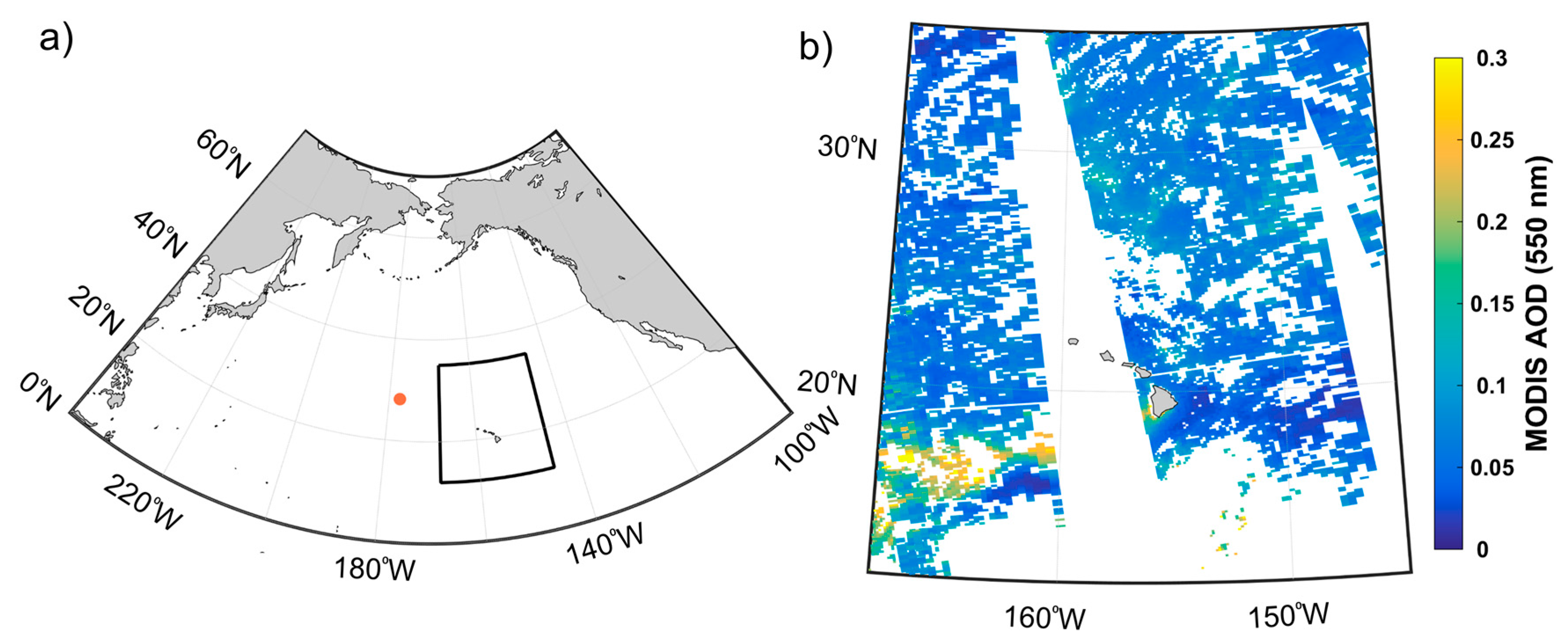
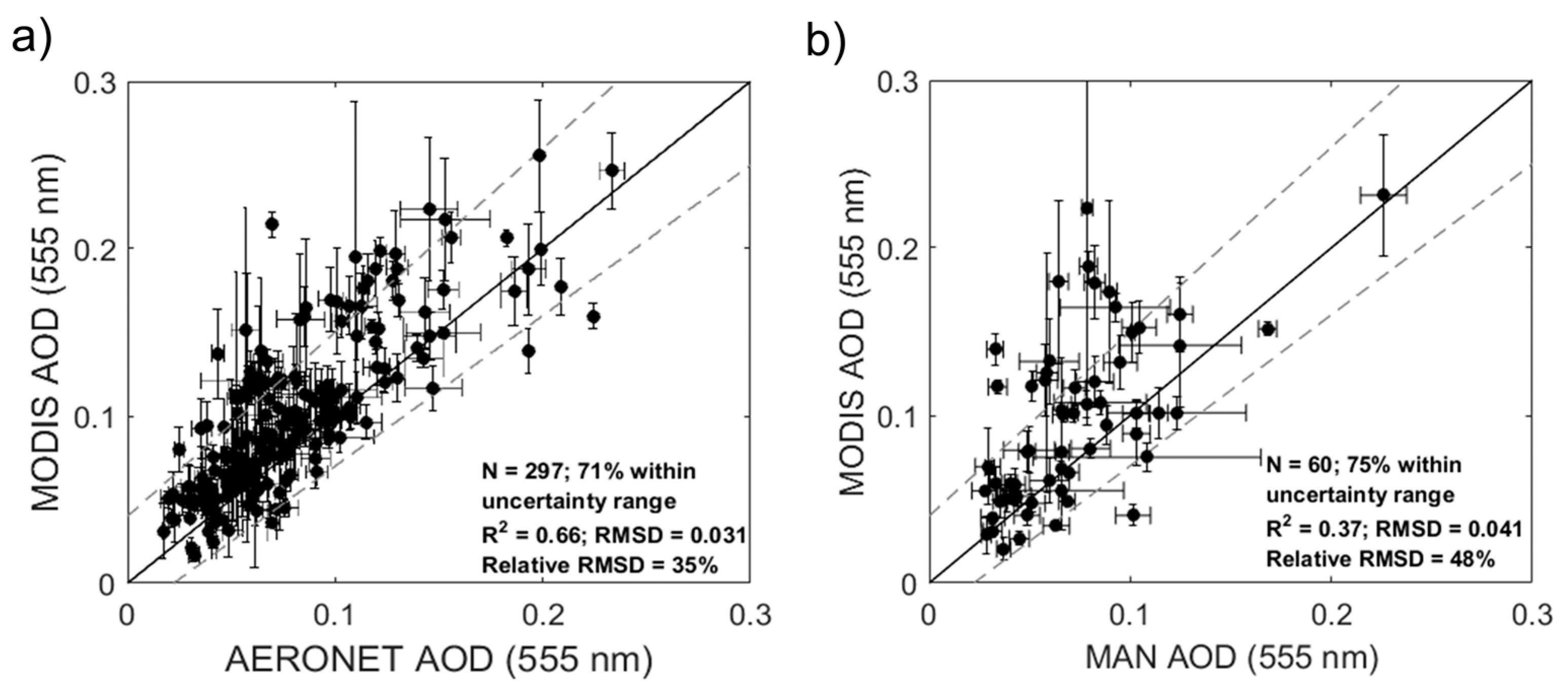
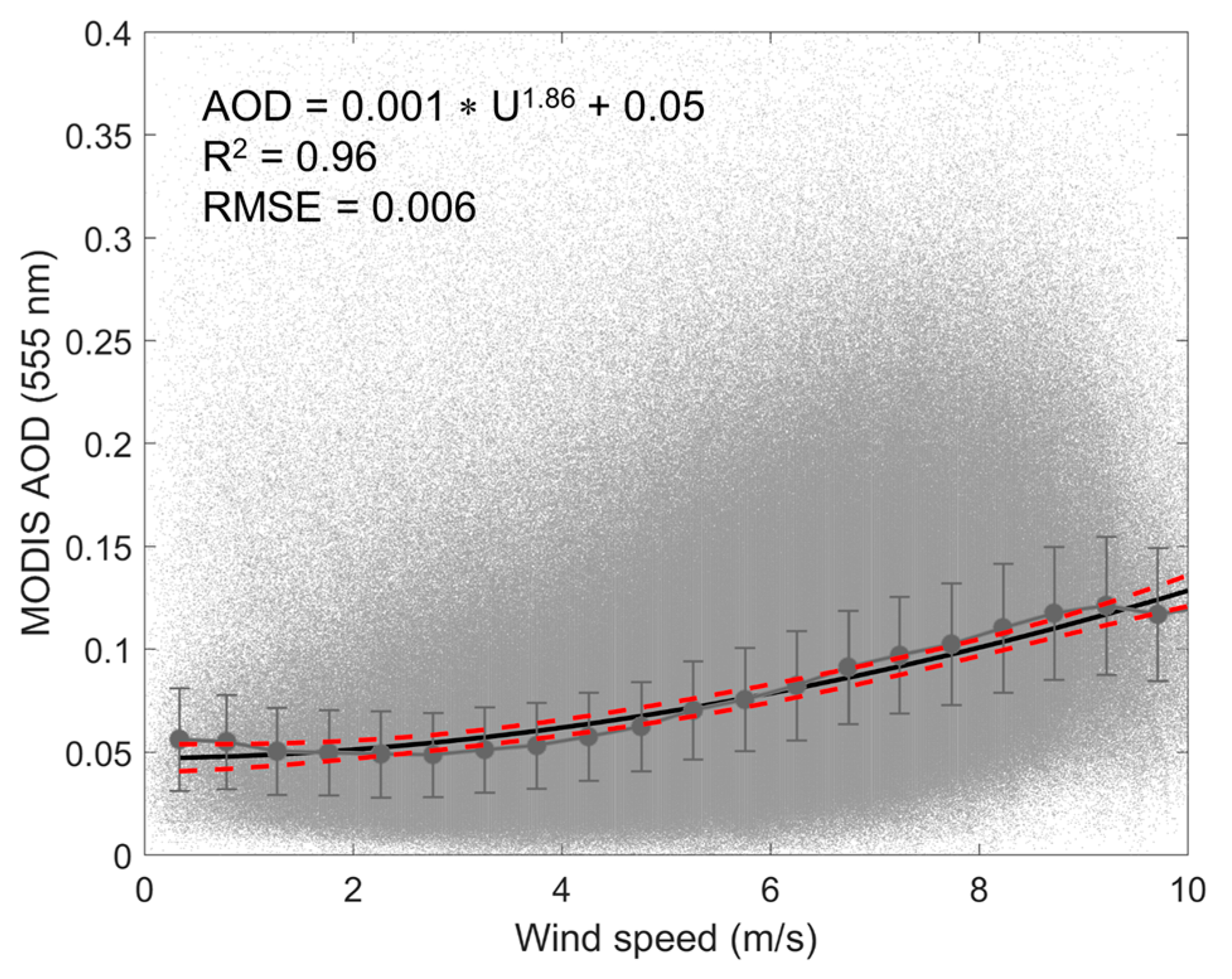
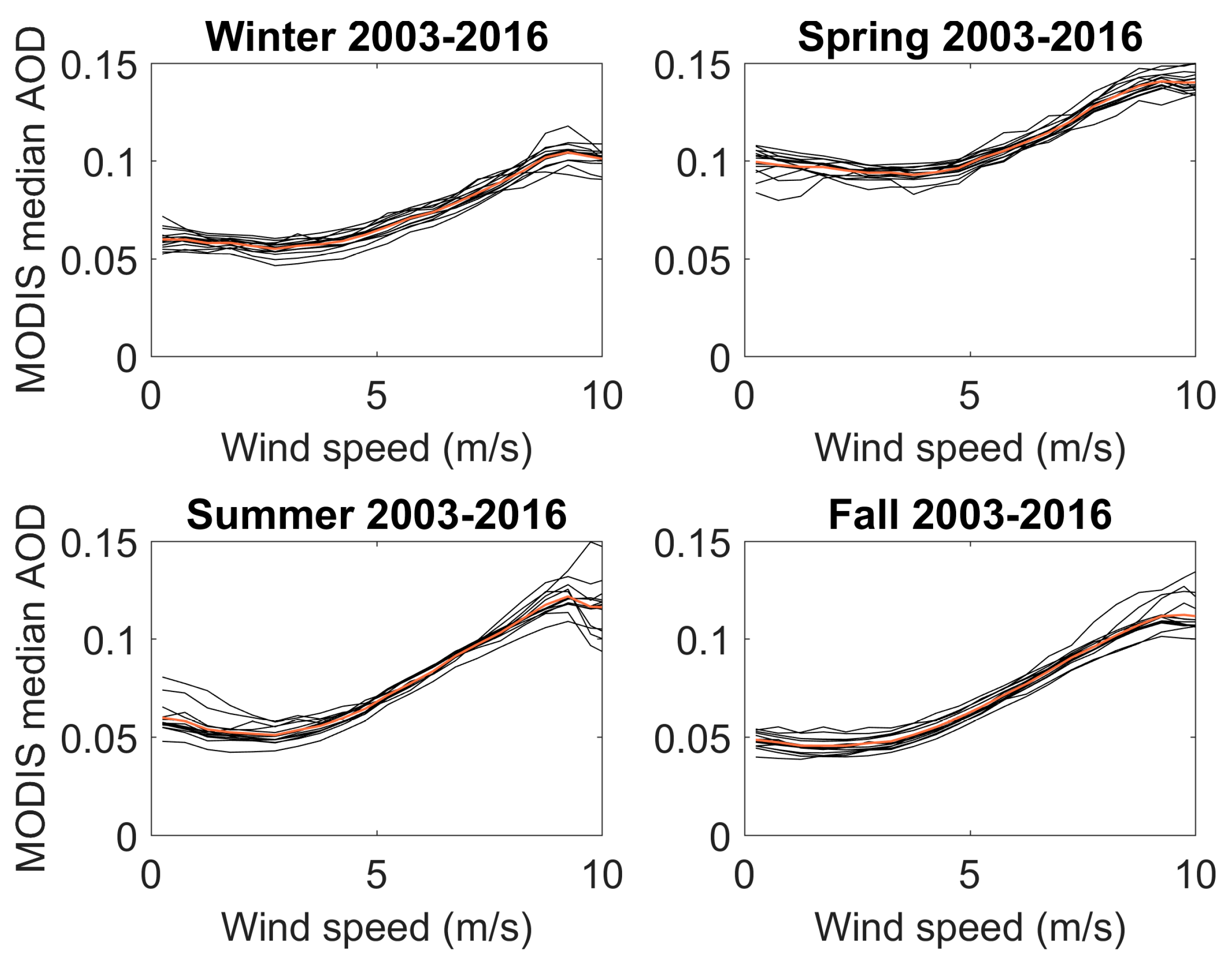
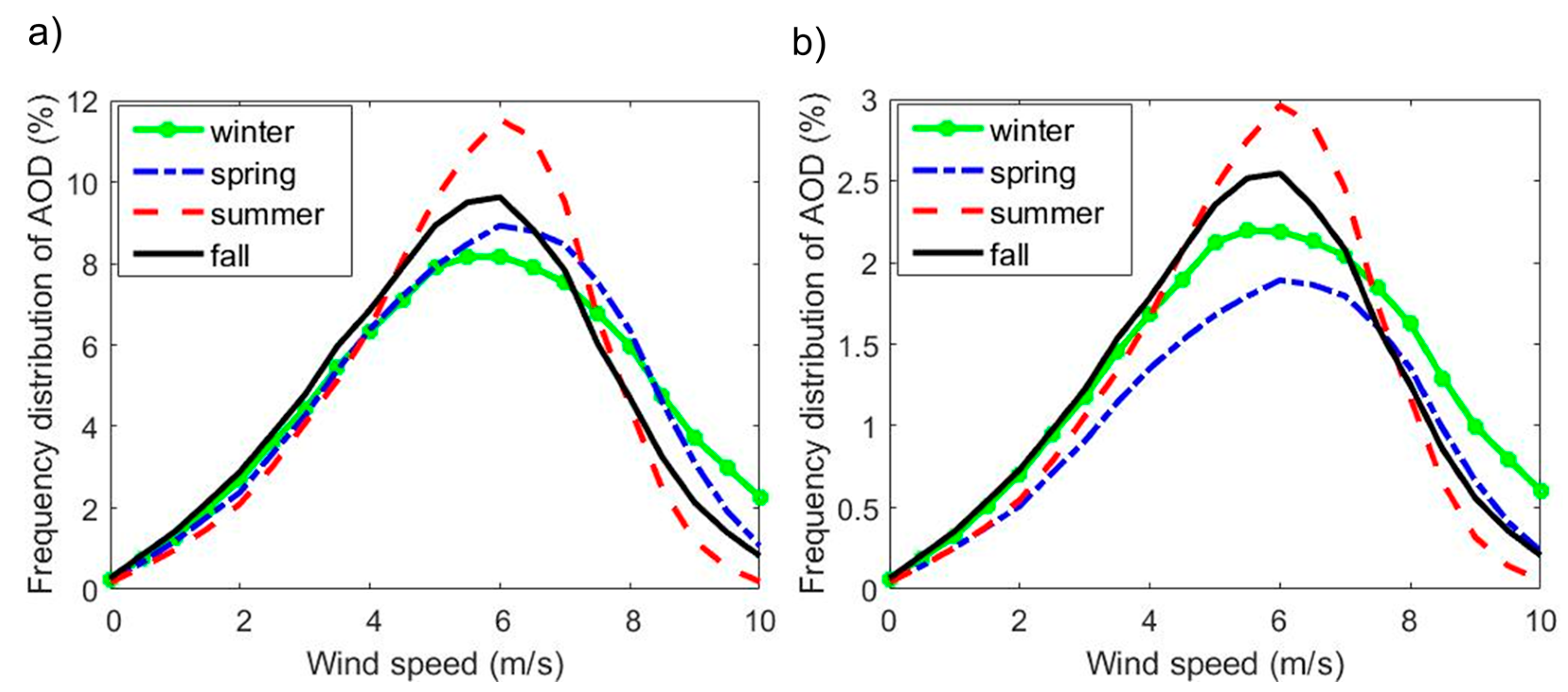
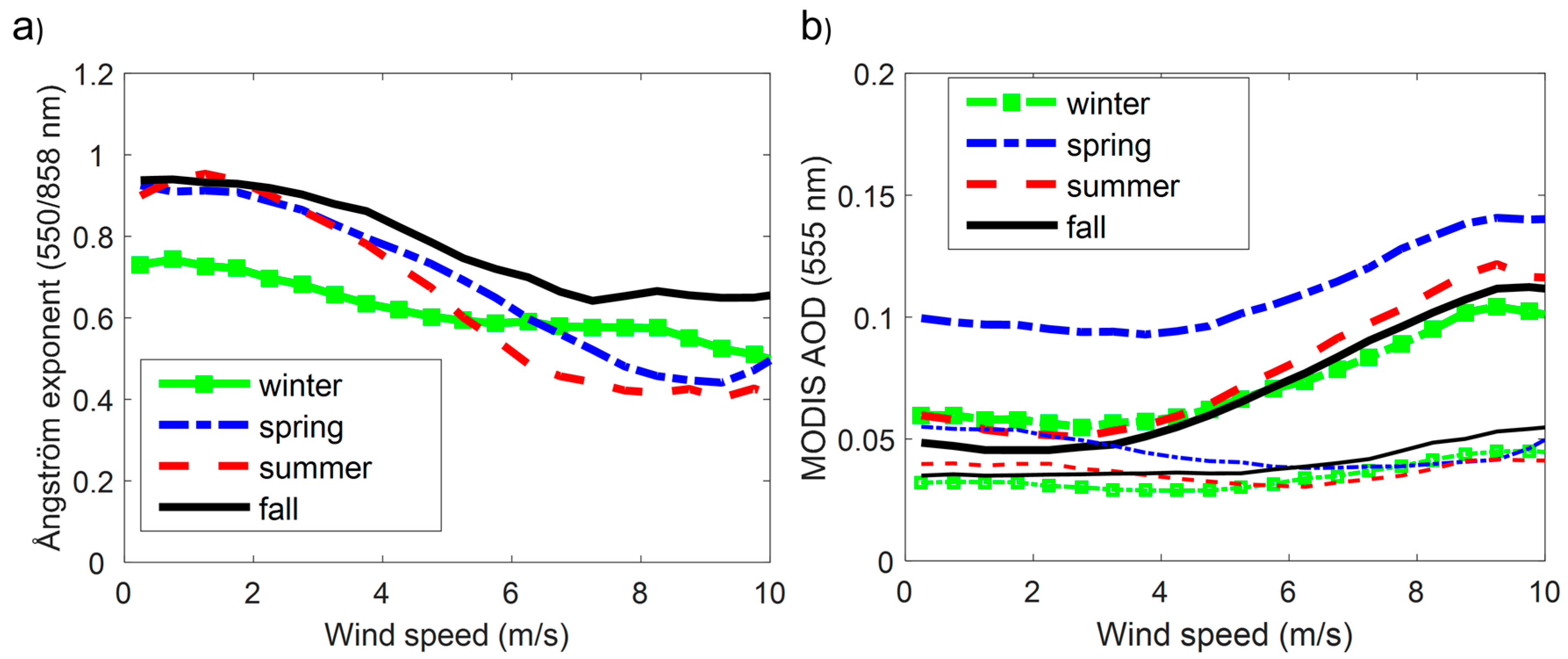

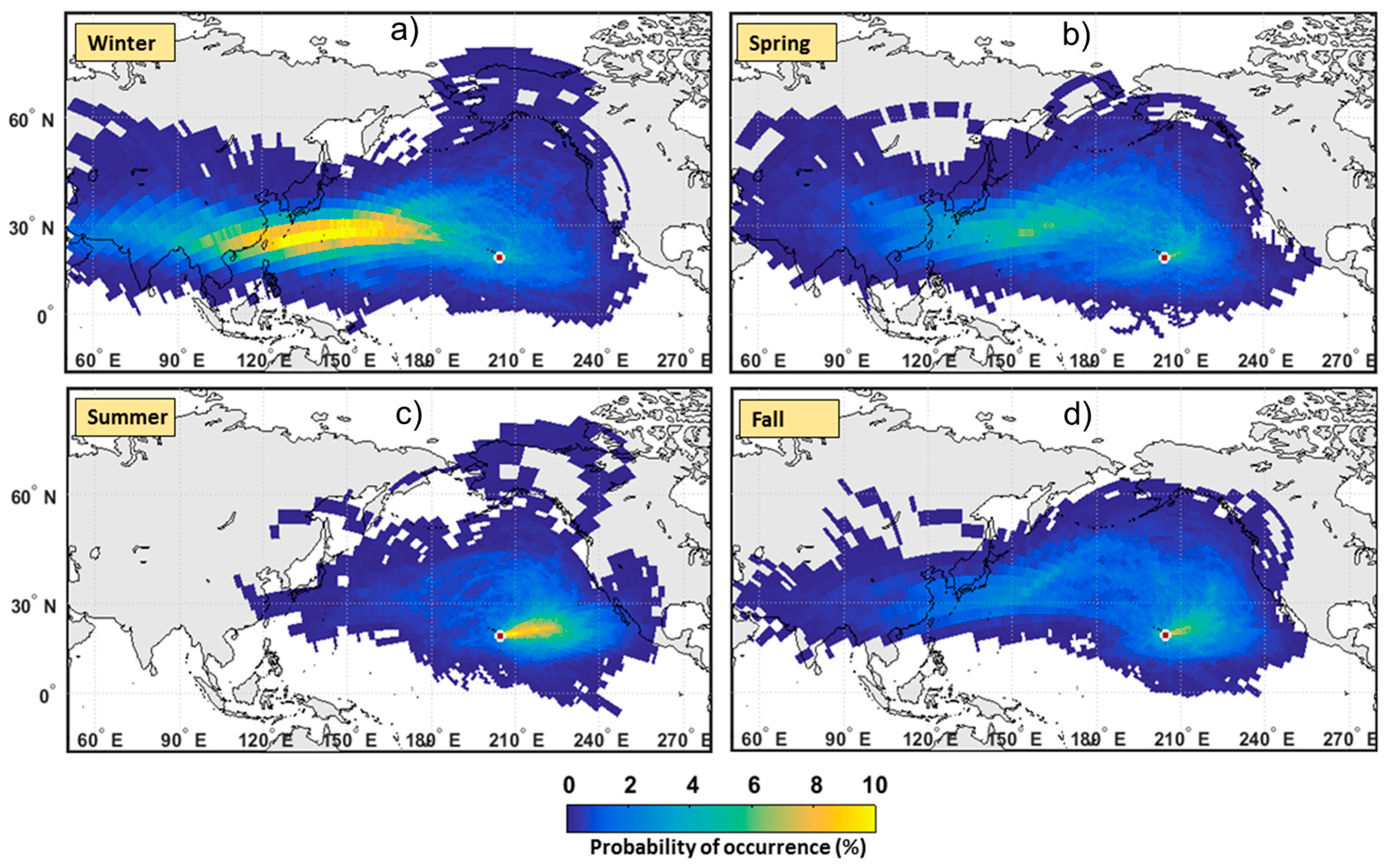
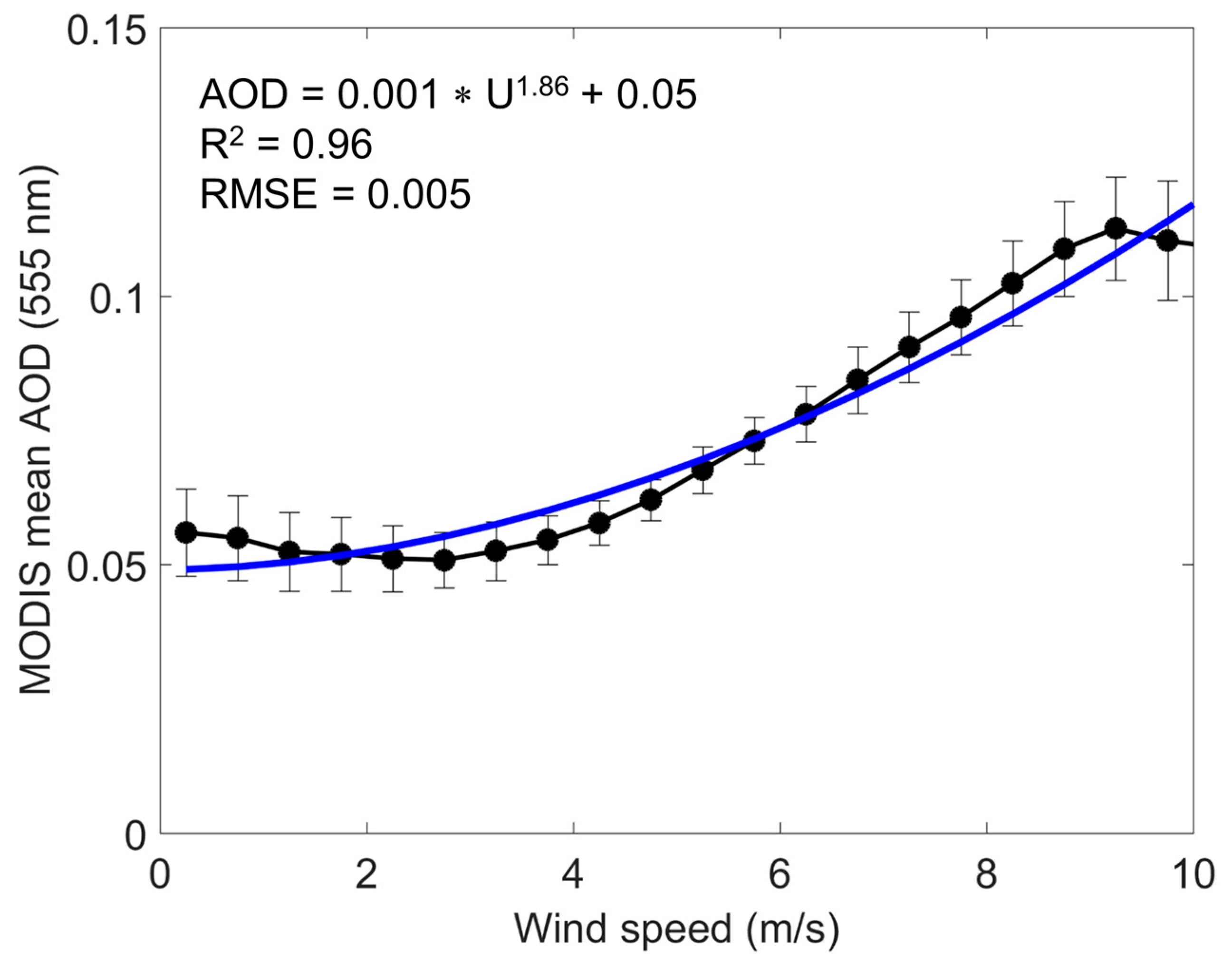


| Year | Cruise Name | Investigation Area | Time Period | Duration |
|---|---|---|---|---|
| 2016 | NOAA Ron Brown | North Pacific Ocean | May | 8 days |
| 2015 | Okeanos Explorer | Around Hawaiian Islands | September | 7 days |
| 2013 | Horizon Spirit | North Pacific Ocean | June–August | 21 days |
| 2013 | RV Kilo Moana | Around Hawaiian Islands | August–September | 13 days |
| 2012 | RV Sonne | Pacific transect from Japan to Fiji Island | September–October | 14 days |
| 2012 | RV Trans Future 5 | Pacific transect from New Zealand to Japan | June | 6 days |
| 2012 | Horizon Spirit | Eastern North Pacific Ocean | September and October | 9 days |
| 2012 | RV Thomas G. Thompson | West coast of Mexico, North Pacific | March–April | 14 days |
| 2011 | RV Kilo Moana | Around Hawaiian Islands | February | 8 days |
| 2010 | RV Roger Revelle | Philippine Sea, North Pacific Ocean | September–October | 11 days |
| 2010 | MV Zim Iberia | Gulf of Mexico, Pacific Ocean | March–May | 41 days |
| 2009–2010 | RV Melville | Pacific latitudinal transect from Brisbane, Australia across the Southern Pacific to South America | November–February | 42 days |
| 2009 | RV Sonne | Western Pacific Ocean | October | 7 days |
| 2008 | MS Trans Future 5 | Pacific transect from New Zealand to Japan | August–September | 13 days |
| 2007 | MS Trans Future 5 | Pacific transect from New Zealand to Japan | May–June | 7 days |
| Relationship | Type | R2 | Investigation Period | Region | References |
|---|---|---|---|---|---|
| AOD555 = 0.001 × U1.86 + 0.05 | power-law | 0.95 | 2003–2016 (fall, winter, summer) | NP a | Current study (MBL h AOD) |
| AOD555 = 0.001 × U1.83 + 0.06 | power-law | 0.96 | 2003–2016 (fall, winter, summer) | NP | Current study (Column AOD) |
| AOD550 = 2.594 × 10−5 × U3.3992 + 0.0212 | power-law | n/a | n/a | S b | [14] |
| AOD550 = 0.00022 × U2.47 + 0.114 | power-law | 0.89 | December 2006 | NP | [56] |
| AOD555 = 0.00032 × U2.3 + 0.028 | power-law | 0.98 | September 2001 | NP | [37] |
| AOD500 = 0.00055 × U2.195 + 0.06 | power-law | 0.97 | January 2002–December 2004 (total 14 days) | MH c, NA d | [36] |
| AOD500 = 0.0036 × U + 0.047 | linear | 0.33 | Different times | Global | [55] |
| AOD532 = 0.15/(1 + 6.7e−0.17×U) | logistic | 0.97 | June 2006–April 2011 | Global | [35] |
| AOD500 = 0.009 × (U − 4) + 0.03 | linear | 0.45 | 2002–2008 | Global | [33] |
| AOD550 = 0.004 × U + 0.085 | linear | 0.95 | 2004 | Global | [34] |
| AOD500 = 0.0068 × U + 0.056; | linear | 0.14 | January 2001–February 2002 | MI e, NP | [32] |
| AOD550 = 0.08 × e0.09×U | exponential | n/a | 2001–2003 | AS f | [38] |
| AOD500 = 4.9 × 10−5 × U3 − 3.7 × 10−5 × U2 + 0.017 | 3rd degree polynomial | n/a | November–December 1995 | SP g | [57] |
© 2018 by the authors. Licensee MDPI, Basel, Switzerland. This article is an open access article distributed under the terms and conditions of the Creative Commons Attribution (CC BY) license (http://creativecommons.org/licenses/by/4.0/).
Share and Cite
Merkulova, L.; Freud, E.; Mårtensson, E.M.; Nilsson, E.D.; Glantz, P. Effect of Wind Speed on Moderate Resolution Imaging Spectroradiometer (MODIS) Aerosol Optical Depth over the North Pacific. Atmosphere 2018, 9, 60. https://doi.org/10.3390/atmos9020060
Merkulova L, Freud E, Mårtensson EM, Nilsson ED, Glantz P. Effect of Wind Speed on Moderate Resolution Imaging Spectroradiometer (MODIS) Aerosol Optical Depth over the North Pacific. Atmosphere. 2018; 9(2):60. https://doi.org/10.3390/atmos9020060
Chicago/Turabian StyleMerkulova, Lena, Eyal Freud, E. Monica Mårtensson, E. Douglas Nilsson, and Paul Glantz. 2018. "Effect of Wind Speed on Moderate Resolution Imaging Spectroradiometer (MODIS) Aerosol Optical Depth over the North Pacific" Atmosphere 9, no. 2: 60. https://doi.org/10.3390/atmos9020060





